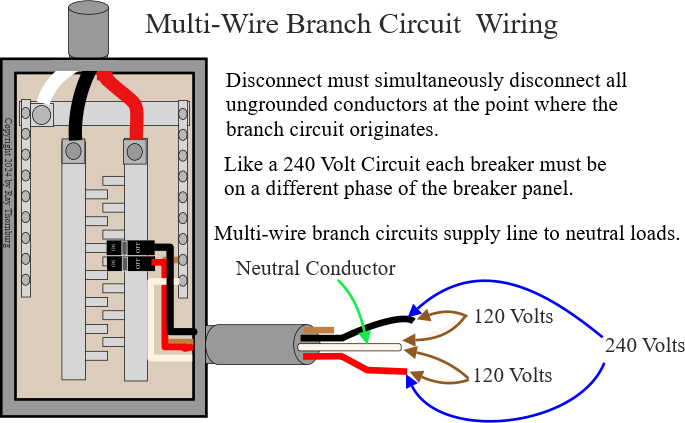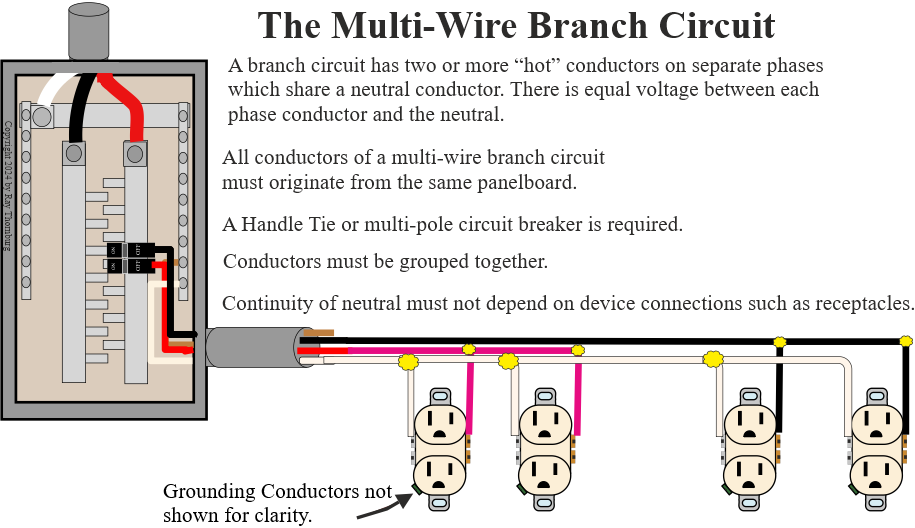Most people are familiar with how a regular 120 volt circuit is constructed (a hot, a neutral and a grounding conductor). Some may even understand how a 240 volt circuit operates (two hots, a neutral and a grounding conductor). But what the heck is a multi-wire branch circuit? Well, a multi-wire branch circuit is kind of a cross between a 240 volt circuit and a 120 volt circuit. It uses a 240 volt cable but it’s wired for essentially two 120 volt circuits. A multi-wire branch circuit is a branch circuit with at least two circuit phase conductors having a voltage between them, with equal voltage between each phase conductor and the neutral conductor. Let’s take a look at the diagram below.
Multi-Wire Branch Circuit Requirements
A multi-wire branch circuit must-
- All conductors of a multi-wire branch circuit must originate from the same panelboard.
- Each multi-wire branch circuit shall be provided with a means to simultaneously disconnect all ungrounded conductors at the point where the branch circuit originates.
- A multi-wire branch circuit shall supply only line to neutral loads. (some exceptions apply)
- The ungrounded and grounded conductors shall be grouped by wire ties or similar means in at least one location in the panelboard.
- Continuity of neutral must not depend on the connection to a device such as a receptacle.
- See NEC 210.4 for more info.
Advantages of a Multi-Wire Branch Circuit
Below are some advantages of this type of circuit.
- Less expensive because fewer conductors are needed (less copper).
- Less labor because there are fewer wires to pull.
- Takes up less space in panelboards and raceways.
- Less (a lot less) voltage drop across a distance.
- Greater flexibility and capacity. You’re essentially getting two circuits instead of just one. This can be handy in some wiring situations (like wiring a detached shed for instance).
Disadvantages of a Multi-Wire Branch Circuit
Multi-wire branch circuits are safe if installed correctly however there are some things to watch out for.
- Connections need to be secure and tight. A loose neutral for instance anywhere in the circuit can cause an over-voltage condition on one side and an under voltage condition on the other side of the circuits. This could destroy delicate electronic equipment for instance or cause a fire. A loose neutral can happen many years after original construction during routine maintenance repairs like changing out a receptacle for instance.
- A multi-wire circuit works best when the loads are balanced because there’s less return current on the neutral. Though this is not a defect it’s something to consider during installation.
- In some cases a multiwire branch circuit causes issues with arc-fault and GFCI breaker types.
- Safety to workmen- Because the neutral is shared between two breakers workmen need to be careful to spot a multiwire circuit and turn both breakers off before working on a circuit. This can be an issue in older homes where the workmen didn’t tie the breakers together with a handle tie. In this case flipping only one breaker there would still be the unbalanced current on the neutral and the workmen could get shocked.
- Installation Errors- Common installation errors include:
- not using a handle tie,
- using separate breakers on each side of the panel,
- wiring it through a device,
- or not making sure the breakers are on opposite phases. This last one is a potential fire hazard because it would tend to overload the neutral.



